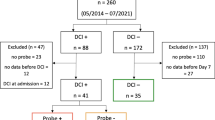Abstract
Introduction
Vasospasm is a major cause of morbidity after subarachnoid hemorrhage (SAH), and current screening techniques (angiography, transcranial Doppler [TCD], and clinical examination) have serious limitations. Brain oximetry is a promising noninvasive tool to detect reduced brain oxygenation from vasospasm.
Methods
Consecutive SAH patients at high risk for vasospasm were monitored with the INVOS (Somanetics, IL, USA) 5100C cerebral oximeter. We prospectively collected oximeter readings (rO2) with concurrent values for vital signs, intracerebral pressure (ICP), arterial blood gas measurement, and hemoglobin (HGB). Data were prospectively collected every 12 h and at clinical events (angiography, transfusion, etc.). We prospectively recorded clinical history, clinical events, radiology results, and outcomes.
Results
Six patients were measured 123 times. rO2 values were correlated with the contralateral side, HGB, blood pressure, and PaO2, but not with ICP or perfusion pressure. There were no measured effects of angiography or transfusion. Patterns relating rO2 readings to clinical, angiographic, or TCD evidence of vasospasm were unclear, and there were no associations with the outcome (cerebral infarction, NIH Stroke Scale, or modified Rankin Scale).
Conclusion
INVOS rO2 readings are associated with other factors that relate to cerebral oxygen delivery but seem to be of limited use as a screening tool for vasospasm or cerebral infarction after SAH.


Similar content being viewed by others
References
Rosengart AJ, Schultheiss KE, Tolentino J, Macdonald RL. Prognostic factors for outcome in patients with aneurysmal subarachnoid hemorrhage. Stroke. 2007;38:2315–21.
Sen J, Belli A, Albon H, Morgan L, Petzold A, Kitchen N. Triple-H therapy in the management of aneurysmal subarachnoid haemorrhage. Lancet Neurol. 2003;2:614–21.
Tejada JG, Taylor RA, Ugurel MS, Hayakawa M, Lee SK, Chaloupka JC. Safety and feasibility of intra-arterial nicardipine for the treatment of subarachnoid hemorrhage-associated vasospasm: initial clinical experience with high-dose infusions. AJNR Am J Neuroradiol. 2007;28:844–8.
Polin RS, Coenen VA, Hansen CA, et al. Efficacy of transluminal angioplasty for the management of symptomatic cerebral vasospasm following aneurysmal subarachnoid hemorrhage. J Neurosurg. 2000;92:284–90.
Muench E, Horn P, Bauhuf C, et al. Effects of hypervolemia and hypertension on regional cerebral blood flow, intracranial pressure, and brain tissue oxygenation after subarachnoid hemorrhage. Crit Care Med. 2007;35:1844–51.
Stiefel MF, Spiotta A, Gracias VH, et al. Reduced mortality rate in patients with severe traumatic brain injury treated with brain tissue oxygen monitoring. J Neurosurg. 2005;103:805–11.
Shah N, Trivedi NK, Clack SL, Shah M, Shah PP, Barker S. Impact of hypoxemia on the performance of cerebral oximeter in volunteer subjects. J Neurosurg Anesthesiol. 2000;12:201–9.
Demet G, Talip A, Nevzat U, Serhat O, Gazi O. The evaluation of cerebral oxygenation by oximetry in patients with ischaemic stroke. J Postgrad Med. 2000;46:70–4.
Nemoto EM, Yonas H, Kassam A. Clinical experience with cerebral oximetry in stroke and cardiac arrest. Crit Care Med. 2000;28:1052–4.
Newman DH, Callaway CW, Greenwalk IB, Freed J. Cerebral oximetry in out-of-hospital cardiac arrest: standard CPR rarely provides detectable hemoglobin-oxygen saturation to the frontal cortex. Resuscitation. 2004;63:189–94.
Cuadra SA, Zwerling JS, Feuerman M, Gasparis AP, Hines GL. Cerebral oximetry monitoring during carotid endarterectomy: effect of carotid clamping and shunting. Vasc Endovascular Surg. 2003;37:407–13.
Samra SK, Dy EA, Welch K, Dorje P, Zelenock GB, Stanley JC. Evaluation of a cerebral oximeter as a monitor of cerebral ischemia during carotid endarterectomy. Anesthesiology. 2000;93:964–70.
Beese U, Langer H, Lang W, Dinkel M. Comparison of near-infrared spectroscopy and somatosensory evoked potentials for the detection of cerebral ischemia during carotid endarterectomy. Stroke. 1998;30:895–7.
Dunham CM, Sosnowski C, Porter JM, Siegal J, Kohli C. Correlation of noninvasive cerebral oximetry with cerebral perfusion in the severe head injured patient: a pilot study. J Trauma. 2002;52:40–6.
Schwarz G, Litscher G, Kleinert R, Jobstmann R. Cerebral oximetry in dead subjects. J Neurosurg Anesthesiol. 1996;8:189–93.
Gomersall CD, Joynt GM, Gin T, Freebairn RC, Stewart IE. Failure of the INVOS 3100 cerebral oximeter to detect complete absence of cerebral blood flow. Crit Care Med. 1997;25:1252–7.
Tseng M-Y, Czosnyka M, Richards H, et al. Effects of acute treatment with pravastatin on cerebral vasospasm, autoregulation, and delayed ischemic deficits after aneurysmal subarachnoid haemorrhage. Stroke. 2005;36:1627–32.
Claassen J, Bernardini GL, Kreiter KT, et al. Effect of cisternal and ventricular blood on risk of delayed cerebral ischemia after subarachnoid hemorrhage. The fisher scale revisited. Stroke. 2001;32:2012–20.
Brady KM, Lee JK, Kibler KK, et al. Continuous time-domain analysis of cerebrovascular autoregulation using near-infrared spectroscopy. Stroke. 2007;38:2818–25.
Torella F, Haynes SL, McCollum CN. Cerebral and peripheral oxygen saturation during red cell transfusion. J Surg Res. 2003;110:217–21.
Yoshitani K, Kawaguchi M, Miura N, et al. Effects of hemoglobin concentration, skull thickness, and the area of the cerebrospinal fluid layer on near-infrared spectroscopy measurements. Anesthesiology. 2007;106:458–62.
Jaeger M, Schuhmann MU, Soehle M, Nagel C, Meixensberger J. Continuous monitoring of cerebrovascular autoregulation after subarachnoid hemorrhage by brain tissue oxygen pressure reactivity and its relation to delayed cerebral infarction. Stroke. 2007;38:981–6.
Schmidt JM, Rincon F, Fernandez A, et al. Cerebral infarction associated with acute subarachnoid hemorrhage. Neurocrit Care. 2007;7:10–7.
Acknowledgments
Somanetics (the device manufacturer) loaned the INVOS device to the ICU while it was evaluated. The hospital purchased the disposable sensors. No other financial support, honoraria, research personnel, consulting fees, statistical support, or other support were provided. The authors collected the data in a database of their own design and maintained control at all times. They were responsible for the data analysis and the decision to submit the data for publication. This work was supported in part by grants to AMN from the Neurocritical care Society, Novo Nordisk, and the Northwestern Memorial Foundation.
Author information
Authors and Affiliations
Corresponding author
Rights and permissions
About this article
Cite this article
Naidech, A.M., Bendok, B.R., Ault, M.L. et al. Monitoring with the Somanetics INVOS 5100C After Aneurysmal Subarachnoid Hemorrhage. Neurocrit Care 9, 326–331 (2008). https://doi.org/10.1007/s12028-008-9077-8
Published:
Issue Date:
DOI: https://doi.org/10.1007/s12028-008-9077-8




